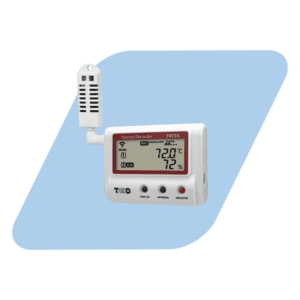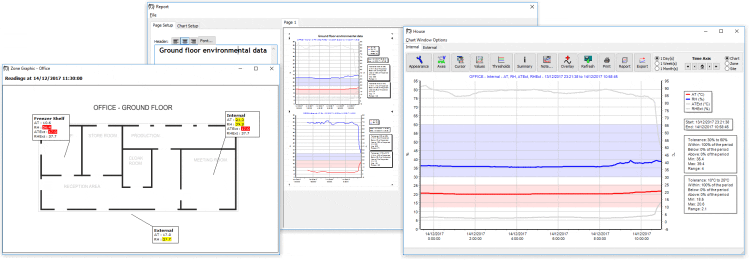Data Loggers Assist Curators with Protecting Their Collections
In galleries and museums, accurate and reliable environmental monitoring data is essential for managing the preservation process. In fact, many art and curative organizations will not loan their collections out unless the institution in question can prove that they have a monitoring system in place to ensure that the art is always stored in safe conditions.
Some lenders require one or more years of climate-control readings before agreeing to place any exhibitions in a new gallery. They ask for evidence of the environmental data to be submitted in the Facility Report, a document adopted by the American Alliance of Museums when applying for and receiving exhibits and loans.
 A data logger is an ideal device to continuously record environmental data and archive the readings for later analysis and report generation. In this brief overview, we cover the basics of environmental monitoring and how it helps curators to protect their collections.
A data logger is an ideal device to continuously record environmental data and archive the readings for later analysis and report generation. In this brief overview, we cover the basics of environmental monitoring and how it helps curators to protect their collections.
Climate Control Verification
Manual data collection is very time-consuming and retrieving the data can be difficult especially if there are multiple locations being monitored. In the case of old, delicate artwork, temperature and relative humidity (RH) must be closely controlled and kept at suitable levels (generally a temperature of 68° to 72°F, and RH of 50% with +/- 5% fluctuation). Warmer temperatures can cause heat damage to certain objects, and high RH levels can lead to mold formation and cause objects to corrode, warp, crack, or cockle.
Fragile paintings and other artwork also need to be protected against excessive illumination and ultraviolet light to prevent the degradation of pigments in the paint. Through automated monitoring, facilities can ensure that their protective measures (such as UV light filters and tinted window glazing) are fully effective. Another key challenge is balancing the optimal conditions for preservation and those for occupant comfort. Data loggers are also useful to verify an internal climate control HVAC system.
Transporting Artwork
Temperature and humidity alarm systems are commonly used in libraries, archives, and document storage rooms, as well as for transporting these valuable assets between facilities. Pieces in transport require a compact, battery-powered, lightweight solution with adequate internal memory to record all the necessary environmental parameters during transit.
In some transport applications, there is an additional requirement to record shock and/or vibration, where the items being shipped are extremely fragile. Also, protection of especially valuable items during shipment can often justify the additional expense of a cellular-based system that can provide immediate alerts (SMS message or email) if conditions such as temperature or humidity stray outside an acceptable range.

What Should You Monitor?
Common parameters of interest in museum applications include:
- Temperature
- Humidity
- Visible light (Illuminance) and Ultraviolet light (UV levels)
Environmental data loggers track and alarm temperature, humidity, and illuminance/UV light to protect artwork and other installations in galleries and historical sites. These values can all be monitored with high accuracy. Turn-key solutions are also available to save users from the difficulty and cost of installing a wired system in an existing facility.
Whether you need a simple, single-channel unit to log temperature or a multi-channel system to log several temperature inputs and other parameters at the same time, you can find a data logger to meet your exact needs.
How to Monitor Temperature
At the most basic level, there are two types of temperature loggers:
- Complete units that come with a built-in external sensor
- Units that require the addition of a separate temperature sensor
Many temperature data loggers come equipped with their own internal sensors, so you don’t have to purchase and connect any sensors. This is ideal when you just need a quick solution, say for monitoring temperature in a single room.
While complete units offer the easiest solution, the sensor supplied with the unit may not be suitable for all applications. For example, tracking the temperature of a document in a sealed case. In this case, a data logger that accepts a standard type of external sensor, like a thermocouple, will allow the selection of a custom probe that better suits the need of a specific application.
The number of temperature measurement points depends on the application. In some instances, the temperature sensors will be dedicated to specific pieces of artwork. In other cases, the temperature measurement will be used to monitor the general environment. In most applications, one measurement point per 100-200 sq. ft. will usually be adequate unless the gallery is oddly shaped or there are wide variations in airflow within the area.

How to Monitor Humidity
Humidity is an important parameter to track when you’re storing materials such as metals, cloth or tapestry, and paper products. Rot and rust are common results in facilities that neglect high humidity levels. As with temperature sensor placement, be sure you have enough sensors to give good coverage of the goods or room you’re monitoring.
Specific models of humidity data loggers measure the relative humidity in the surrounding area up to a certain range. For example, one model might measure from 10% to 95% RH while another can record 5% to 95% RH. For many applications, the given range may be enough, but when storing certain materials you’ll want to be sure.
Many of these models record data using their own internal sensors, while others allow you to attach external sensors to facilitate measurement inside enclosures. While typical units might provide 3-5% accuracy, high-accuracy models are also available to provide an accuracy of 1-2% over the full 0-100% humidity range.
How to Monitor Light Levels
Many data loggers use sensors that simultaneously measure and record illuminance/UV intensity. Some devices also calculate the cumulative illuminance and cumulative amount of UV light during recording sessions, which can be viewed without stopping recording. For example, wide-ranged illuminance measurements can range from 0 to 130,000 lx, while UV measurements can range from 0 – 30 mw/cm2. For preservation applications, cumulative readings are often the most critical to ensure the safety of the artwork.
Sample Interval:
For typical museum applications where the environment is relatively stable, fast sampling rates are not a requirement. Most museums don’t need an expensive device that takes a reading every 10 seconds when one reading every 1-5 minutes will warn of rising temperatures or humidity just as well. Choosing a device with a slower sample rate also greatly reduces the volume of data to comb through for reporting or regulatory compliance.
Going Wireless
Because of the sheer size of some exhibit areas, it can extremely difficult to install a wired system. Wireless monitoring systems are ideal for museum interiors to verify that exhibits are being maintained in a controlled and non-damaging environment. Popular communication options include proprietary wireless systems which use unlicensed Industrial Scientific Medical (ISM) frequencies, Wi-Fi, Bluetooth, Cellular, and more.
Typical proprietary wireless systems consist of remote wireless units that automatically monitor storage conditions and transmit all their environmental data and alarms to a wireless gateway, which sends it to an office PC or the cloud. Wi-Fi-connected data loggers are attached to the existing wireless local area network within the facility and can instantly send data to an online cloud server for real-time monitoring and archiving. Bluetooth-connected units will collect and store the data locally and then offer convenient upload to a mobile device such as a smartphone or tablet for viewing analysis and transfer to a PC. Finally, cellular systems are ideal for shipping or for temporary installations where all that is needed is a reasonable cellular signal to send data to a hosted or cloud-based server. These systems also offer the ability to send alarms via SMS text messages in case something goes awry.
The choice of whether to go wireless or wired depends on several factors including your facility’s network, the physical layout, wireless range, and where the data loggers will be installed. A wireless setup saves personnel the cost of installing wiring and the hassle of running lengths of cables through the building.
Wireless systems are ideal when:
- You need to monitor a number of distributed points or floors
- It’s difficult or expensive to run wires from these points back to a central location
- Data needs to be collected and transmitted from a vehicle while it is in motion
- Data and/or alarms need to be collected from a site that is difficult to access or doesn’t have regular internet connectivity.

Wireless Range
Wireless devices can be deployed in hard-to-access locations if necessary, including storage areas and inside display cases, giving personnel easy access to the data using mobile devices. For example, Bluetooth Smart technology enables curators to download the readings wirelessly from up to 10-100 feet away with just a smartphone or tablet. Wi-Fi offers a range of up to several hundred feet, depending on the environment, while a system using proprietary wireless transmission can offer ranges up to 1000 feet or more. Finally, cellular systems can provide coverage anywhere a cellular signal is available. Depending on the type of system, both historical data and real-time data can be accessible.
Who Gets Alarms and How?
Alarm generation is one of the most important factors to consider: do you want a data logger that indicates an alarm by LED or do you need the system to send out email warnings? Many data logger models support several alarm capabilities so you can choose how you want to receive alerts, such as emails or SMS messages on your mobile device, an indicator light, or a local audible alert. All considered, the most effective alarm type is the one you’re sure will go to the right people and be immediately acted upon.
Configuration, Reporting, & Analysis Software:
Typical software capabilities include:
- Configuring and naming sensors
- Automatically updating site data to data files or database
- Sending alarms via email or text message if any channel inputs go outside of safe limits
- Generating reports presenting the data
Sophisticated software packages specifically for these kinds of applications such as DARCA Heritage supplied with the Eltek data loggers allow users to segregate loggers by area and create pictorial representations to track readings by room. This allows users to get a highly accurate environmental profile to aid long-term preservation. This way all data collected is made as meaningful as possible to the museum.

For further information on environmental monitoring systems for Museums and Archives, or to find the ideal solution for your application-specific needs, contact a CAS Data Logger Application Specialist at (800) 956-4437 or request more information.

